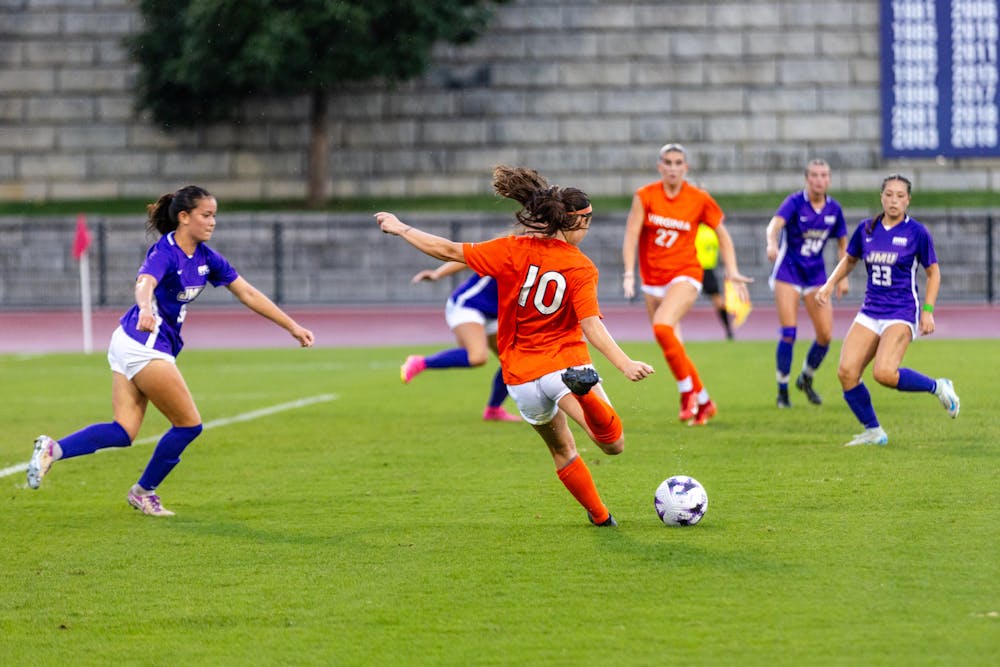A month into the season, Virginia women’s soccer looked to be one of the favorites for the NCAA title. The Cavaliers at one point held down the No. 2 spot in the national poll after a resounding 8-0-0 start. They dominated opponents with an aggregate goal differential of 22-2 in those games, which included six shutout victories and a road win over No. 3 Penn State.
Then, three weeks ago, the real test began. Virginia entered the most difficult four-game stretch of its season. First, a home match against Wake Forest, who had dispatched them 2-0 the season prior. Then No. 16 Notre Dame and a pair of road trips to North Carolina to play the No. 4 Tar Heels and No. 2 Duke.
With an opportunity to prove themselves as a juggernaut, the Cavaliers instead watched their season unravel in front of them. They lost all four games, conceding 10 goals and scoring only three. The team’s inefficiency in the attacking third, which had been a weakness in several games early in the season, began to rear its ugly head consistently when the real competition came.
They plummeted from No. 2 to No. 14 after a 3-0 annihilation by the Demon Deacons. Then it was to No. 19 after a 1-0 loss to the Fighting Irish. Then No. 25 the week after their 3-2 defeat to the Tar Heels. Following a defeat to the Blue Devils last week, Virginia’s losing streak sits at four games. With five regular season matches to go, the Cavaliers have fallen to 13th in the 17-team ACC — only the six best teams even qualify for the conference tournament.
Virginia’s poor performance in the ACC thus far cannot be attributed to either key injuries or bad luck. Sure, each of the Cavaliers’ four losses came to current top-15 teams that have national title aspirations, so some slack should be given to them for that. But Virginia was once one of those title-contending teams, and now it is fighting for a place in the ACC Tournament. As such, they are facing the loaded question — what went wrong?
There is no doubt that the Cavalier roster is full of talent — after all, it boasts two preseason All-ACC selections and multiple players who have competed on the national level. At its best, Virginia has looked like a team that can compete with anybody in the nation. The problem is that the Cavaliers have not played at this level for a complete 90 minutes in the past few games.
Rather it has been a tale of two halves for Virginia over this four-game skid. The Cavaliers have followed a trend of displaying precise passing movements and high intensity in the first 45 minutes but coming out of the halftime break flat.
Against Notre Dame, Virginia registered 11 shots in the first period but mustered only four in the second half, even after the Fighting Irish scored the go-ahead goal in the 47th minute. The Cavaliers were also tied at the break with North Carolina but were unable to prevent their eventual defeat. It was the same story against Duke — Virginia may have scored its lone goal in the final period, but it came only after the game was well out of reach thanks to a lackluster performance following halftime.
In short, the second-half Virginia team has been doomed by sloppiness and apparent fatigue, as they have been consistently outshot in the latter stages of their matches.
This inconsistency is not unique to the losing streak, though. The problem was just masked against far inferior competition early in the season. Only three of Virginia’s first eight opponents currently have winning records — Penn State, Utah Valley and James Madison, the latter two of which compete in mid-major conferences.
Even during the dominant eight-game winning run, Coach Steve Swanson was critical of the Cavaliers’ lack of shot quality and tendency to revert to sloppy habits late in games. Virginia scored only twice with 24 shots against Towson and found the net just once with 11 shots against VCU. In short, inefficiency in the attacking third of the field has come back to bite the Cavaliers against defenses that do not allow as many chances throughout the course of a game.
The level of athleticism boasted by ACC opponents has also been tough for Virginia to deal with. While the Cavaliers are no slouch, they have looked as if they do not have the speed on the back end to match the runs of opposing forwards, nor the strength to play physically in the box on crosses. Those weaknesses have been made apparent by a handful of the 10 goals the team has surrendered in their last four games, most recently in the 3-1 loss to Duke during which Virginia was dominated both in the box and in transition.
The porous defense may come as a surprise because a highlight of the team’s early-season success was their stout backline that did not allow a goal over four consecutive games. That, however, was not a strong indication of an all-around fortified defense. This success was more so due to Virginia’s control of possession, which limited the time opposing teams spent with the ball in the Cavaliers’ defensive third.
Though the Cavaliers have faced the worst of their schedule, every game remaining is against a conference opponent and will carry the added pressure of being a must-win if they want to keep their postseason hopes alive.
It is evident Virginia is good, but the Cavaliers are not in the tier of teams that will make deep runs in the ACC and NCAA postseason this year. The Cavaliers have shown flashes of a team that could contend. Bad teams do not win eight games in a row. But the great teams perform on the biggest stage, and Virginia has been unable to do that thus far.







